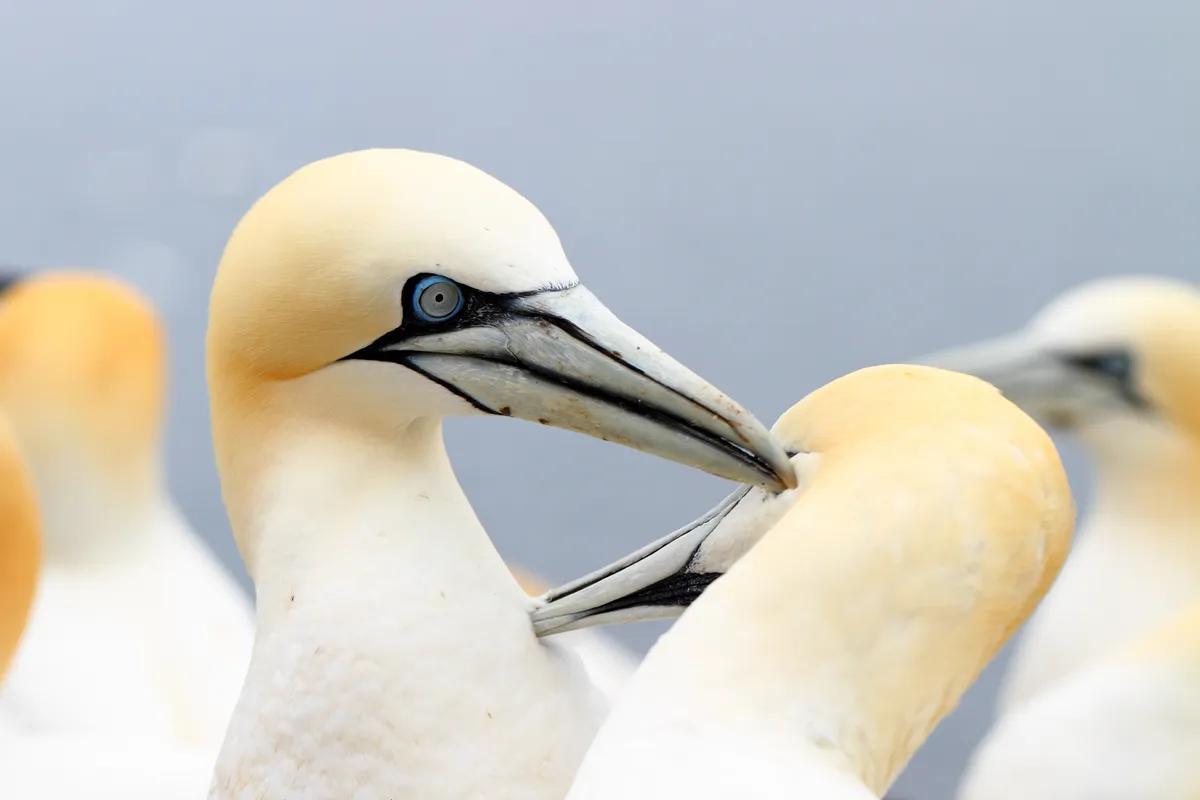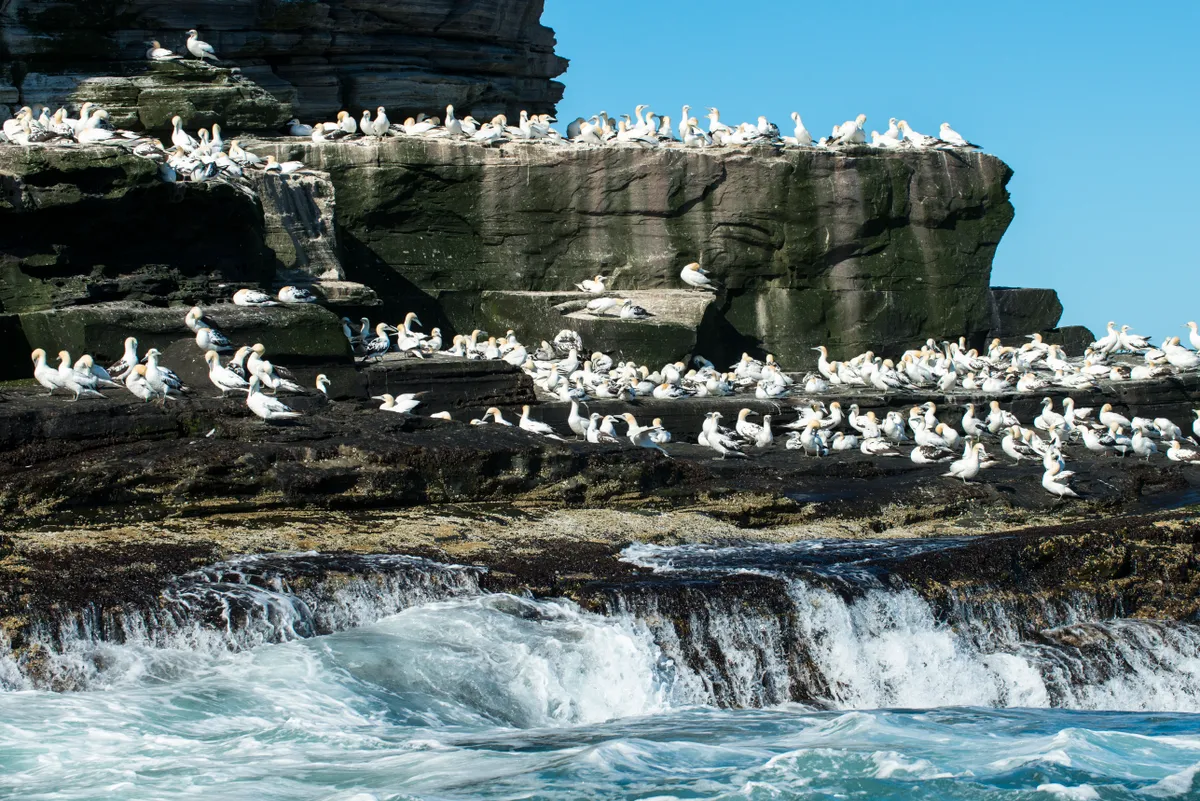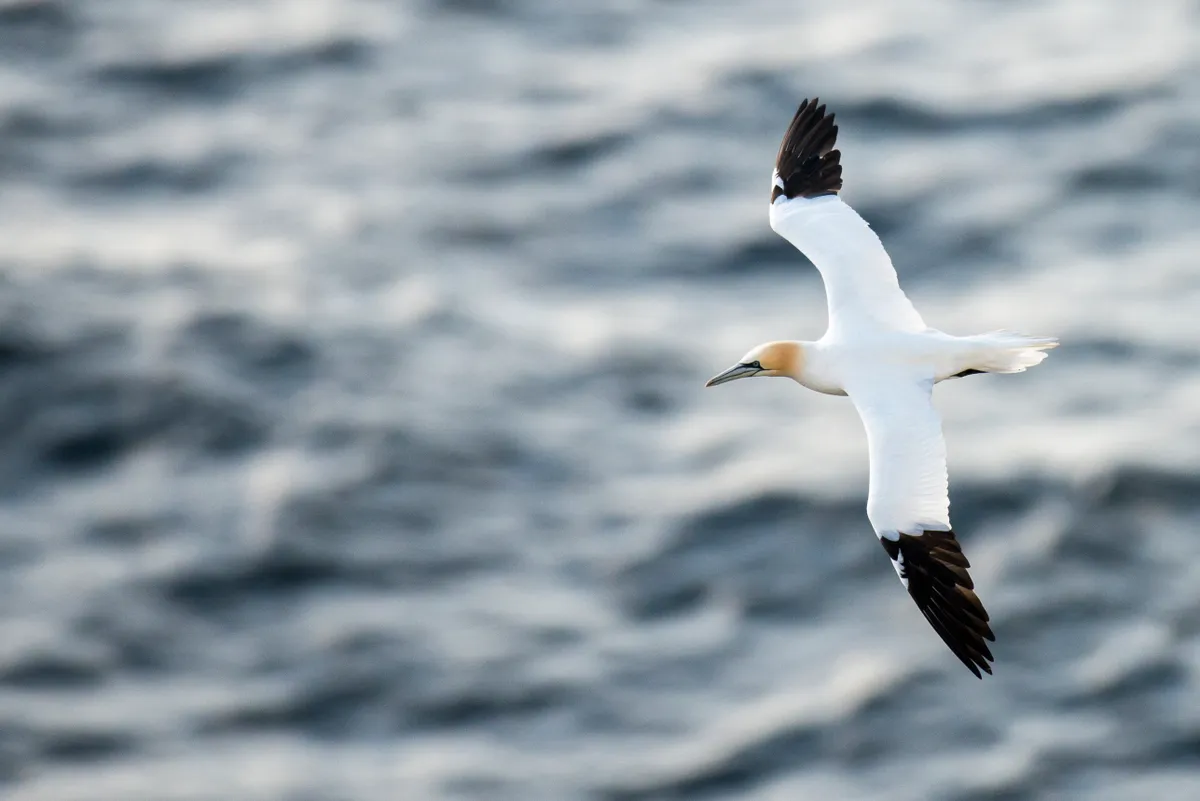Gannets are large white seabirds easily recognised thanks to their unique diving methods. The sight of gannets hunting is like no other, a spectacle that ranks as one of the greatest wildlife wonders to be seen in the UK.
Here, wildlife photographer Richard Shucksmith presents his expert guide to gannets, with details of where to see them, how to identify, anatomy, hunting techniques, what they eat, and mating patterns.

Where do gannets live?
The preferred breeding grounds for gannets are towering sea cliffs on remote and windswept offshore islands. Safe from large mammalian predators, these refuges are surrounded by the gannet’s favourite food: oily fish. Feeding is important to the gannet: these birds carry a lot of fat, providing both the insulation that allows them to save energy while in icy waters and a fuel store to tide them over in lean times.
Gannet colonies are also windy places, and wind is especially important to the gannet. Its long narrow wings are adapted for distant foraging out at sea, but they make landing and taking off difficult without assistance from the wind. Remote island cliffs provide strong updraughts, which the gannet uses to land and take flight.
Visiting a gannet cliff on foot provides a different experience. Approaching a cliff edge, before you even see the birds, the noise of thousands of gannets and the strong, acrid smell of guano hits your senses. Looking down from the clifftop, you see a swirling mass of gannets, like a throbbing giant white organism, encrusting the cliff face.

Looking closely at the white-covered ledges, however, you will see organisation, a remarkable pattern of thousands of evenly spaced nests about 80cm apart – just enough to accommodate two large adults, including room for mutual display and a large chick.
Gannets build substantial nests, often using seaweed to form the base. A sticky gelatin found in seaweeds helps stick the nest to the rock. The finished structure is around 30cm across, with a nest cup in the middle. Grass and other material floating in the sea are incorporated into the nest. It is rare today to find a gannet’s nest without some form of plastic in it, such as rope and old fishing nets. This causes problems – mainly entanglement. It is not unusual to see a gannet hanging from the cliff by a piece of rope and suffering a slow, painful death.
With adjacent nests so close to each other, the collective noise and pair-bonding displays, from bill-tapping to mutual preening, stimulate all the birds, enhancing reproductive success throughout the colony. This helps gannets lay their eggs early, so their young fledge before the winter storms.
Gannet mating patterns
Gannets mate for life and return to the same nest year on year. They lay one egg, and both sexes incubate, taking about 44 days to hatch. The newborn chick is about 11cm long and weighs 70–80 grams. Just 13 weeks later, the chick is eight times bigger at about 90cm long, and – at over four kilos – more than 50 times heavier.
How do gannets hunt?
To get the chick to that weight, the gannets must feed on rich, seasonally predictable fish such as herring, sand eels and, in particular, mackerel, which are rich in nutrients and oils. The latter are plentiful inshore from June to September.
Offshore, the gannet is virtually the only seabird that feeds on them; only a gannet has the weight to plunge deep enough to catch a mackerel, and the strength to handle these powerful fish.
The evolutionary adaptations required to catch these relatively large fish are remarkable. Gannets will plunge-dive anything from nine metres to 15 metres above the sea, reaching up to 60mph when they enter the water. Their wings fold right back, turning their bodies into a tight, streamlined shape, so they travel further and faster into the water without their wings being damaged on impact.
To reduce the chances of impact injuries, air sacs in the head and neck inflate – like airbags in cars. The gannet’s nostrils are fused, preventing water from entering the sinuses. They have binocular vision and the ability to adapt their eyesight by changing the shape of the lens in a split second to give them pinpoint vision both above and below the waves for catching fish.

The dive only allows the bird to reach depths of a few metres, but gannets can swim very well underwater, using both wings and feet for propulsion – this enables them to plunge even deeper, pursuing fish down to around 30 metres.
Gannets have two dive types: one V-shaped, which lasts only a few seconds; the other U-shaped, in which the bird swims and may be submerged for around 20 seconds. The U-shaped dive is about 50% more successful at catching prey.
Gannet migration
Having built their strength on fish, the juvenile gannets soon migrate south up to 5,000km, almost to the equator of west Africa. At the same time, adult gannets migrate to the Mediterranean and as far as Morocco and Senegal.
Many UK seabird species have gone through some difficult times over the past few decades, as changes in sea temperature affect their food supply. Gannets, though, are a rare success story. Gannet populations are increasing by between 3% and 5% per year, thanks to well-managed mackerel and herring stocks. The gannet now has a UK population of around 600,000 (240,000 nesting pairs). That’s internationally significant, comprising 60–70% of the global population.
All of which means that, with luck, gannets will remain in Britain’s wild places for generations to come – and their vibrant, thronging, noisy colonies will continue to be one of the must-see places to visit for an unforgettable wildlife experience.

Anatomy of a gannet
- Name: Northern gannet, Morus bassanus
- Size: the gannet is the UK’s largest seabird.
- Length: 87–100cm
- Wingspan: 165–180cm
- Weight: 2.4–3.6 kg
- Lifespan: typically 17 years. The oldest-known gannet is 37 years, four months and 16 days old, shown through ringing studies.
- Gannets take five years to reach maturity.
- Appearance: both sexes are very similar in appearance. They have eyes like raptors, their binocular vision allowing them to perceive depth. They are able to adapt their eyesight by changing the shape of the lens in a split second, giving them pinpoint vision both above and below the waves for catching fish.
- Air sacs: located in the head and neck, these inflate on breathing in, to reduce the chances of impact injuries.
- Nostrils: these are fused, preventing water from entering the sinuses.
- Wings: by folding their wings right back (see opposite), gannets turn their bodies into a tight, streamlined shape (hydrodynamic) that prevents their wings being damaged on impact with the surface and allows faster travel in the water.

Where and when to see gannets
The best time to see gannet colonies is in summer, from May to August.
- Troup Head in Aberdeenshire, with 2,000 pairs.
- Bempton Cliffs on the Yorkshire coast, with 13,000 pairs.
- Bass Rock is the world’s largest gannet colony with more than 75,000 pairs of gannets. This is probably one of the easiest islands to visit, with boat trips run by the Scottish Seabird Centre at North Berwick, East Lothian, just 20 miles east of Edinburgh. seabird.org
- St Kilda is a dramatic isolated archipelago 40 miles west-northwest of North Uist in the North Atlantic Ocean. It has a million-plus seabirds nesting on the islands with more than 60,000 pairs of gannets and is the second-largest colony. Several companies do boat tours to St Kilda, from the Isle of Harris, Uist and Skye.
- Grassholm National Nature Reserve in Pembrokeshire is home to 39,000 pairs of gannets, the third-largest colony in the world. Several companies run boat trips to the island, including the RSPB-accredited Thousand Island. ramseyisland.com
- Ailsa Craig in the Firth of Clyde is one of RSPB Scotland’s most-spectacular and least-accessible reserves, with 33,000 pairs of gannets. Boat trips go from mainland Scotland and the Isle of Arran.
- Noup Cliffs on Westray, Orkney, has 1,500 pairs of gannets and is run by the RSPB. Orkney’s inter-island ferry takes you to the island of Westray, where the colony can be visited on foot.
How to photograph gannets
Trying to shoot a natural feeding frenzy of thousands of gannets diving on a shoal of fish has proved impossible in the UK – so we photographers have had to improvise.
Gannets have learned to follow fishing vessels, feeding on discards or bycatch – the unwanted fish thrown back overboard. So I mimicked a fishing vessel to create a gannet feeding frenzy. That was 10 years ago; the technique is now perfected. By building chutes that release dropped fish two to three metres below the surface, I can mimic shoaling fish. I have tried several ways – hanging over the side of the boat, using a pole-cam, snorkelling and diving – and they all work. By far the most exhilarating is to be in the water myself. The gannets dive incredibly close, within a few inches, but never hit me. I may get an occasional wing in the face, but with the gannet’s ability to pinpoint the fish, I never get hit – it’s not in the gannet’s interest to hit an object when diving into water.
Every summer, I photograph and film this dramatic spectacle and help other photographers and film productions.

